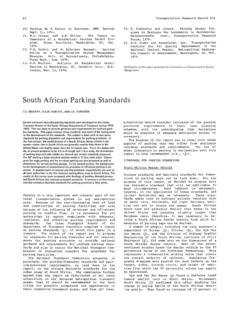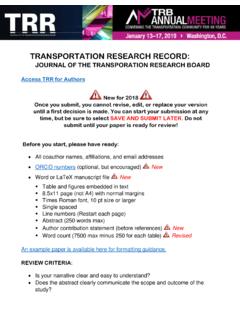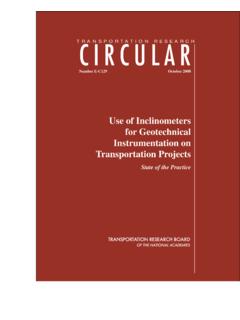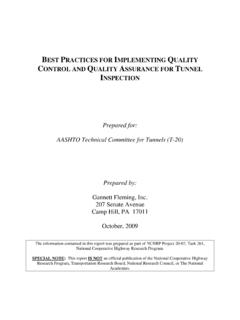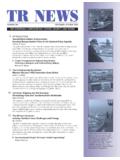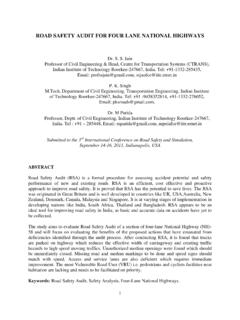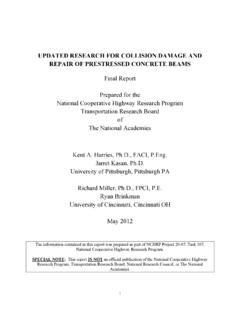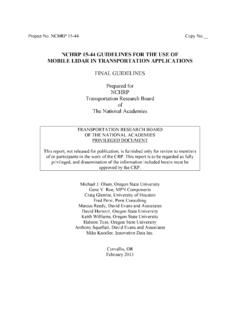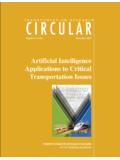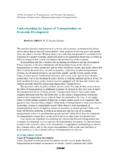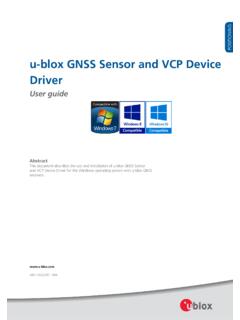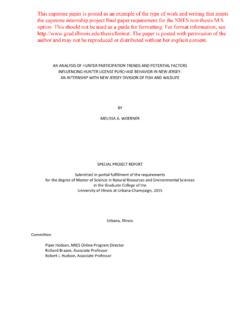Transcription of Information Technology in Transportation: Key Issues and a ...
1 A5003: Committee on Information Systems and TechnologyChairman: Jeffrey L. WesternInformation Technology in TransportationKey Issues and a Look ForwardJEFFREY L. WESTERN, Wisconsin Department of TransportationBIN RAN, University of Wisconsin, MadisonState-of-the-art computer Technology has undergone an almost incomprehensibletransformation, analogous to the evolution from Morse code to e-mail. Although therudimentary scope, goals, and objectives of the transportation community have notchanged significantly, the challenges of Technology today are greater than ever a generation, computers have transformed the everyday tasks of the workforce computer use has infiltrated almost everywhere.
2 Data management capabilities havegreatly enhanced resource management. However, accompanying the positive effects arethe challenges of implementing, supporting, and funding these technologies in the world the gap between cutting-edge Technology and its applications, as well asidentifying the missing links for applying Technology in transportation will be the ongoingchallenge. This paper briefly documents the state-of-the-practice in Information systemsand technologies for transportation , as well as the developing role of informationtechnology (IT) in the 21st century. This assessment points to potential solutions fortechnological challenges in such areas as Applying Information systems and Technology in the transportation field; Applying system -user interfaces ( , interactive graphics) as well as datamanagement and data sharing; Using web technologies (Internet, intranets, and extranets) in transportation ; Prioritizing research, development, and demonstration programs to augment workpresently under way; Encouraging the use of common Information system and Information technologysemantics and standards in the transportation field.
3 Facilitating and monitoring Technology transfer as a user advocate amongtransportation organizations, vendors, and universities; and Evaluating the impact of computer technologies on transportation organizations,including gains in growing concerns about the application of advanced computer Technology intransportation involve the following Issues : IT, Management, Data sharing and interoperability, transportation in the New Millennium2 transportation applications, and Information ISSUEST ransportation Applications of Web TechnologiesIn applying web technologies, the focus in the new millennium will be on advances in real-time technologies, such as zero-latency and push , Intranet, and Extranet Information TechnologiesThe transportation community should emphasize the applications of the Internet, intranets,and extranets in the design, construction, and operation of transportation facilities.
4 Specifically in the following areas: Data exchange and communication over the Internet or extranets; Cross-platform integration of transportation Information sources; Dynamic generation and presentation of transportation Information on the Internet; Information dissemination and management using organizations intranets; and Integration of transportation databases with the Internet, intranets, and Future Revolutions in ITThe transportation community should identify and prepare for future revolutions in IT thatwill have an impact on transportation . One revolution is the likely near future transitionto 64-bit Wintel systems.
5 This transition will have a tremendous impact on distributedcomputing (such as the web) and on data management applications. Many organizationswere caught off-guard and were unprepared or unwilling to make the initial investment inthe 32-bit Windows 95 revolution and have lagged behind ever ComputingThe market penetration of hand-held and in-vehicle computers will provide a platform formany transportation applications. How can we take advantage of these new technologies?Virtual RealityVirtual reality may be useful for facility design and prototyping and should be Wireless NetworksHow can high-bandwidth wireless networks be used effectively in transportationtechnology?
6 Consumer Electronics ExplosionThe consumer electronics (CE) market is poised for explosive growth. Market-readyproducts supporting mobile computing and electronic commerce, and wirelesscommunications supporting E911 locations, smart cards, and the like have made theirdebuts already. What impact will they have on public and private transportation services?Which CE technologies offer major opportunities for reengineering? For example, how canmotor vehicles exploit e-commerce? We barely understand the dynamics of the boundarybetween the public and private sectors and are about to be overcome by technologicallysavvy Systems and Technology3 New Philosophies and Techniques for Systems DevelopmentThe interaction among interoperability, consumer electronics, and in-house softwaredevelopment is already undermining the entire concept of enterprise computing.
7 Whereis the transportation enterprise in a globally connected, consumer-driven, component-based universe? Enterprise solutions are just more stovepipe thinking, as isolatingultimately as the stovepipe applications they were intended to replace. What newphilosophical and technical foundations will guide the development of new systems? Is thewhole concept of system artificial and self-limiting? How should the ideas ofnonlinearity, complexity, autopoeisis, and cybernetics be introduced into transportationsystems? Institutions of higher education and the National Aeronautics and SpaceAdministration (NASA) are exploring these areas.
8 New applications derive fromnonclassified military air and space technologies. The gathering of transportation data (forvehicles, rail, and aircraft traffic), analytic processing, and Information presentation totransportation operation centers might be vital in the 21st century. Many of the largecompanies that have contracts with the military and NASA, such as Boeing, NorthropGrumman, and Lockheed-Martin, can be resources for the transportation community. Thiskind of engagement could allow research facilities, using Department ofTransportation (DOT) grants, to develop processes, techniques, and management systemsusing high-altitude reconnaissance and ground surveillance aircraft equipment,geosynchronous satellite sensors, and data collection and telemetry programs.
9 TheTransportation Research Board should help develop consortiums among the states,universities, aerospace and aviation companies, and DOTs to discover solutions fortomorrow s topics and types of IT that will be of increasing interest to the transportationcommunity include Software and hardware security, Mobile communications, Automatic equipment identification, Electronic data interchange, Global positioning systems, geographic Information systems (GIS), Visualization and animation, Electronic funds transfer, Voice recognition, Sophisticated bar-coding, Airborne ground surveillance, Satellite ground surveillance and tracking, Very large-scale computing, Distributive and client-server technologies, and Advanced analysis and modeling ISSUESS tandardized Methods for Benefit Cost AnalysisIt is important to develop standardized methods for benefit and cost (BC) analysis for theimplementation of IT in transportation agencies.
10 BC analysis traditionally has beenTransportation in the New Millennium4difficult for IT. Managers and politicians are less patient and less willing to accept the intangible benefits of SafetyAs software becomes a more integral part of transportation systems, software safety issuesarise. We must ensure that the software does no harm if it should fail. We do not want theequivalent of the Thorac X-ray machine accidents, in which several patients died due todefective software, to occur in transportation . But safety is not the same as security,although they are interrelated; safety goes beyond security.
